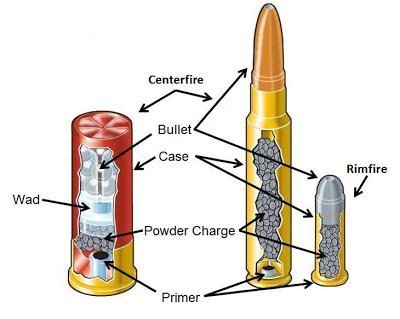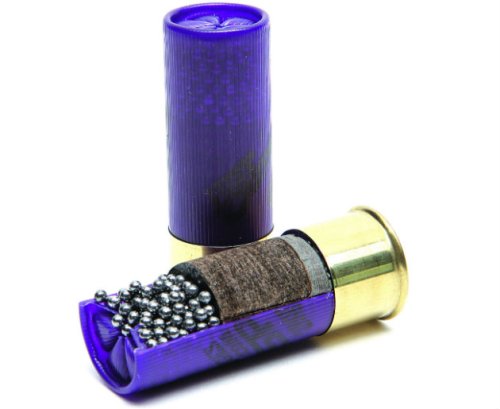Ammunition is the foundation of firearms, yet it is not understood too well by anyone. Just look at the number of people confusing “ammo” with “bullets,” and you will see. In this article, we hope to give you a clear answer to the question “What are the basic parts of ammunition?” and help you understand your gears!

Contents
What Is Ammunition?
The world of firearms and ammunition is vast and confusing because of the specialized terminologies well known by all gun enthusiasts. The term “ammunition” is easily confused with “cartridge” or “bullets,” and that’s not the mislabel you want to happen while you are shopping!
So what is ammunition? It is a term that defines everything and anything that comes out of a weapon to cause damage. If you are using your firearm, then your ammunition is a series of cartridges that produce bullets. But guns are not the only weapons there are, so there are lots and lots of types of ammunition.
A crossbow uses a bolt or an arrow, a slingshot throws rock or a ball, and whatever you can shove into a catapult’s basket can be considered ammunition. Once you take a broader view, you will notice that a circuit knife thrower’s ammunition is none other than the bag of knives at his belt.
The fitting way to call your firearm’s ammunition is “cartridge” – also known as the solution that gun manufacturers use to let users avoid putting in bullets one by one. “Cartridge” also has a variety of widely used colloquial terms like “round” or “loud,” depending on where you are.
The reason why using the word “bullet” for firearm ammunition may turn some heads is understandable. A bullet is but a small part of a cartridge, and god knows how many bullets are there in a cartridge because of market variety. Calling ammunition “bullet” can be similar to your family calling your three-course meal “an entree” and telling you to make more.
What Are The Basic Parts Of Ammunition?

Now that you know what ammunition is and why we will be referring to it as “cartridge” from this point on, let’s get down to the basic components. Many cartridges you usually see at the store will follow the same production guideline, which leads them to have four main parts: the case, primer, propellant, and projectile.
Similar to that, a shotgun cartridge (or a shell as those in the industry call it) often have five parts instead, with an addition of a wad.
Without further ado, let’s take a look at how these things work together to create the power of your firearm. We will also be considering if there are any alternative options available in the current market.
#1. Cartridge Case:
The cartridge casing is the container of everything else on this list. The case acts as a frame for every other part to stay in its designated place before the ammunition is put into use. Usually, the casings are made out of paper in the past, which is then burned or thrown out when you fire the gun.
Nowadays, firearm cartridges make use of a metal or plastic case. Brass, steel, and aluminum are the most easily seen in typical cartridge casings, while plastic cases are usually reserved for shotguns. This is why you occasionally hear people refer to cases as “brass,” but the variety of material used has rendered the term inaccurate and obsolete.
When you are at the store to find what kind of cartridge would fit your gun, perhaps considering the chamber size as your guideline would be most effective. If you don’t do this step properly, your ammunition gets jammed way more often.
Usage is the next factor to consider aside from size and fit. If reloading the casing is what you intend to do in the future, going for brass or brass-related casing is most suitable.
#2. Propellant:
The first few firearm models were designed to utilize gunpowder as their main source of propellants. Gunpowder was so effective at producing explosive masses of gas that it was also implemented in the use of canons as well.
Gunpowder had since lost its appeal because it was rather hard to control once burned, leading to cases where the gun exploded in the shooter’s hand. Nowadays, gun manufacturers aim to refine the design of firearms and their propellant to make guns more stable and clean.
New burning chemicals for guns have been optimized to reduce the risks while maintaining the strength of firearm ammunition. The most popular substance you will see today is a careful mixture of saltpeter, sulfur, and charcoal.
#3. Primer:
But the propellant will not be able to work without a primer, as the substance cannot catch fire on its own. The primer is a small part near the edge of the cartridge case, which prompts the propellant to be activated after being struck by the firing pin.
The primer also contains a nearly identical substance in the propellant to empower it. The change of substance in primers is for the same reason as the one for propellant: to keep your gun safe, stable, and effective.
Looking out for casings with good-quality primers is helping your gun respond better to the firing process. If you do not have a reliable primer, you will likely end up with delayed shots, or your gun will not fire at all!
#4. Projectile:
As we have discussed, the function of ammunition is to produce projectiles, and firearm ammunition is no exception. When you hear people refer to “bullet,” “slug,” or “shot,” projectiles are the topic of their conversation.
Modern projectiles are made out of lead, steel, tungsten, bismuth, or any strong metal mix. You may have heard rumors of experts testing out polymer cones for hollow shots, so the possibilities of projectile material are truly endless.
#5. Wad:

A wad is a piece of material that is located in the case between the propellant and projectile. It serves to create a tight space for the propelling gas to gather pressure when the propellant is being burned!
How Do All The Parts Work Together?
When you pull your trigger, the firing pin is released to hit the primer and activate it. Upon impact, the primer starts to burn and prompts the propellant to burn along with it. The mass amount of gas from the fire creates a large pressure on the projectile, causing it to be expelled from the firearm’s barrel!
Conclusion
That is the full answer to the question, “What are the basic parts of ammunition?”
Now with more knowledge about ammunition and gun working mechanisms as a whole, you can safely operate your firearms and become a more responsible gun owner. We wish you luck on future endeavors with your ammunition!

I am Jerry Gonzalez, and my heart beats for the great outdoors, especially in the breathtaking landscapes of Helena, Montana. Engaging with fellow enthusiasts online and at local hunting clubs has been a rewarding experience, and I find great joy in sharing knowledge and experiences with like-minded individuals. My goal is to empower my fellow hunters with well-informed choices, regardless of their experience level.
